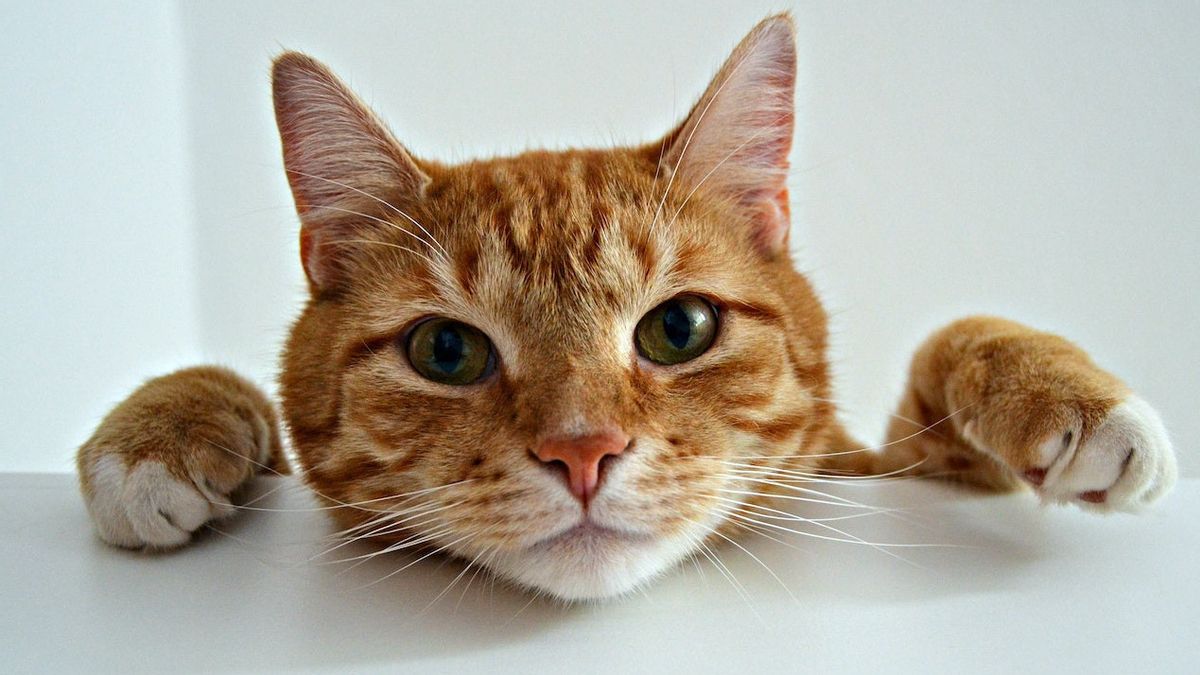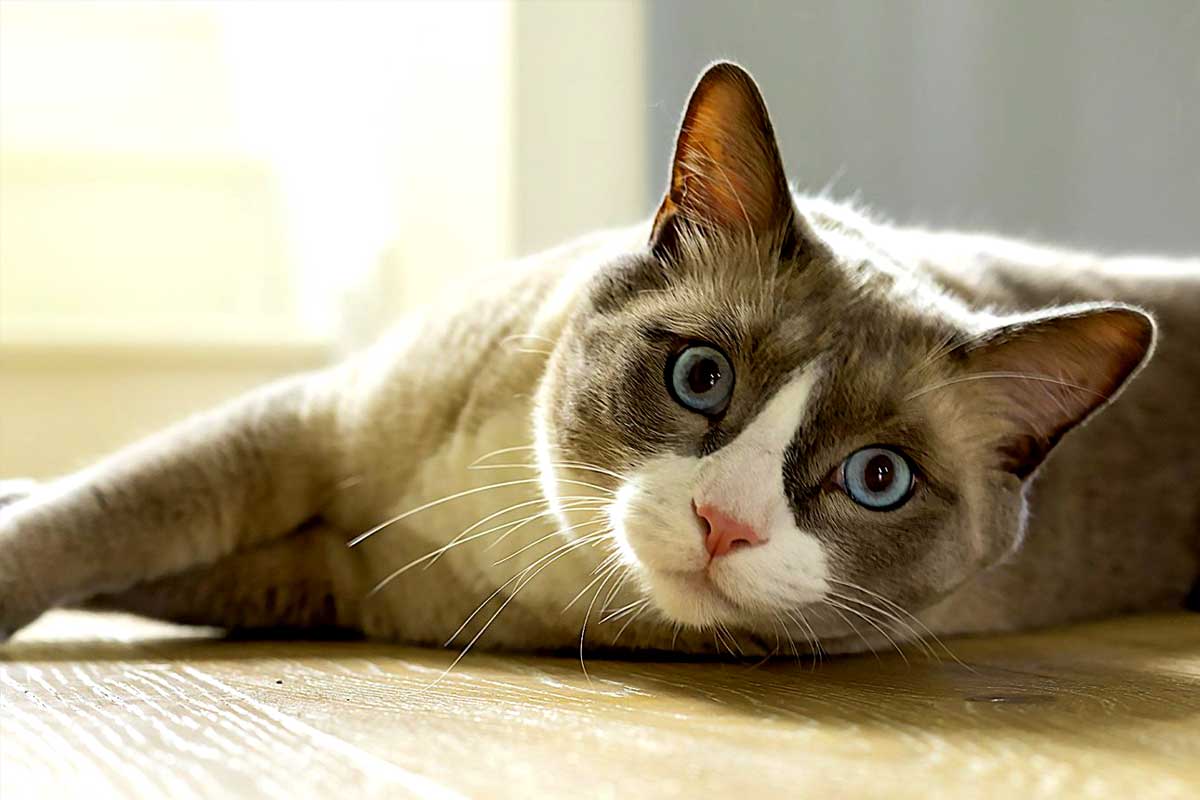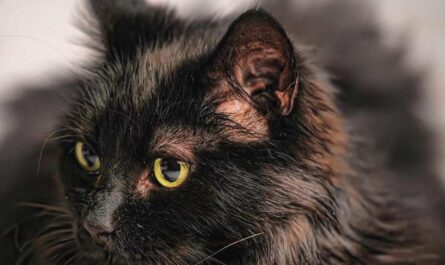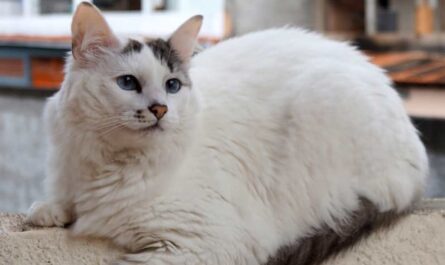How to care for your feline eyes? Have you ever watched your cat stalk a feathery toy across the dimly lit room, their eyes gleaming with an almost supernatural focus? Or perhaps you’ve marveled at their ability to navigate a dark hallway with seemingly effortless precision. Cats possess an extraordinary sense of sight, adapted for a world vastly different from our own. This article will unveil the secrets behind their captivating gaze, delving into the fascinating world of cat vision.
We’ll embark on a journey to explore the unique anatomy of a cat’s eye, uncovering the specialized components that grant them their remarkable night vision and superior motion detection. We’ll also discuss the limitations of their vision, such as depth perception, and how they compensate with their other senses to create a complete picture of their surroundings. Finally, understanding how cats see the world will equip you with valuable knowledge for providing the best possible care for your feline companion.
So, prepare to be amazed as we unlock the mysteries of cat vision, one fascinating detail at a time!
A World Through Feline Eyes: Eye Anatomy and Function
Unlike our round orbs, a cat’s eye boasts a distinctive slit-shaped pupil. This isn’t just a cosmetic difference; it plays a crucial role in regulating the amount of light entering the eye. Behind this captivating slit lies a world of specialized components that contribute to their exceptional vision.
Behind the Slit: A Look Inside the Cat Eye
Imagine peering into a miniature disco ball – that’s what the inner lining of a cat’s eye, called the tapetum lucidum, resembles. This reflective layer acts like a mirror, bouncing light back through the retina, a light-sensitive layer at the back of the eye. This “double exposure” allows cats to capture even the faintest glimmer, making them nocturnal ninjas in the dimmest conditions.
But the tapetum lucidum isn’t the only hero in this story. The retina itself is packed with millions of light-sensitive cells called rods and cones. Rods excel at detecting low light levels, which explains why cats can see so well in the dark. However, cones are responsible for color vision, and cats have far fewer cones compared to humans. This translates to a more limited color palette for our feline friends, with their world dominated by shades of blue and yellow.
Lights Out, Play Time: Masters of the Night
So, why do cats seem to come alive when the sun sets? The combination of the tapetum lucidum and an abundance of rods grants them superior night vision, allowing them to see in conditions that would leave us stumbling in the dark. This exceptional ability to navigate low-light environments is a legacy of their evolutionary past, where they honed their hunting skills under the cloak of darkness.
But it’s not just about seeing in the dark; cats are also incredibly sensitive to movement. Their retinas have a higher concentration of cells dedicated to detecting motion, making even the tiniest twitch or flicker impossible to miss. This heightened sensitivity explains their fascination with flickering objects like laser pointers or dangling toys – it triggers their natural hunting instincts!
Depth Perception: A Blurred Line
While cats excel at seeing in low light and detecting movement, their depth perception isn’t quite as sharp as ours. This is because their eyes are positioned farther apart on their heads compared to humans. This wider placement creates a slightly different perspective in each eye, limiting their ability to precisely judge distances. However, fear not, feline friends! Cats compensate for this limitation with their exceptional sense of touch, using their whiskers to gauge the size and shape of objects in their environment. So, while they might not be able to perfectly estimate the distance to that dangling toy, their whiskers will help them pounce with impressive accuracy.
A Feast for the Motion Detectors: Born to Chase
Have you ever noticed your cat become fixated on a dust mote dancing in a sunbeam? Their heightened sensitivity to movement makes even the tiniest flicker a source of fascination. This is because their retinas have a higher concentration of cells dedicated to detecting motion. Imagine their world as a constant motion picture, brimming with potential prey (or at least, objects that look like potential prey) to chase and explore. This explains their playful nature and their love of interactive toys – it taps into their natural predatory instincts and keeps them entertained for hours on end.
Field of View: A Panoramic Perspective
Cats possess a wider field of view compared to humans. Imagine standing in a field – with human vision, you might only see what’s directly in front of you. However, a cat’s vision encompasses a much larger area, almost panoramic in scope. This wider view grants them a significant advantage when hunting, allowing them to spot potential prey or threats from the corner of their eye. It also contributes to their exceptional agility, as they can take in more of their surroundings with a single glance, aiding in their precise leaps and maneuvers.
Beyond the Basics: Caring for Your Cat’s Precious Peepers
Understanding how cats see the world is not just fascinating, it’s also essential for providing them with the best possible care. Here are some practical takeaways:
- Respect the Darkness: Cats don’t need bright lights at night. Harsh lighting can be overwhelming for their sensitive eyes. Provide them with gentle nightlights or leave them to navigate in the dark, as they’re perfectly adapted to do.
- Location, Location, Location: Place food and water bowls in well-lit areas. While cats can navigate low light, good lighting ensures they can easily locate their necessities.
- Enrichment Through Movement: Cater to their love of movement with interactive toys and activities. A feathery wand or a laser pointer (used responsibly) can provide endless entertainment and keep those sharp eyes stimulated.
- Regular Checkups: Schedule regular veterinary checkups to ensure your cat’s vision remains healthy. Early detection and treatment of any eye problems are crucial for maintaining their precious sight.
By appreciating the unique world cats see and taking steps to support their vision needs, you can strengthen the bond with your feline companion and ensure they continue to navigate their world with confidence and curiosity.
Beyond the Basics: Exploring Unique Feline Vision Capabilities
We’ve delved into the fascinating anatomy of a cat’s eye and how it grants them exceptional night vision and a knack for spotting the tiniest movement. But the feline world of sight holds even more surprises! Let’s explore some of the unique visual abilities that set cats apart from their human companions.
Ultraviolet Vision: Seeing a World Beyond Our Imagination?
Imagine a world where dust motes dance with an otherworldly glow, or where your favorite feline friend can spot hidden markings left behind by other animals. Recent research suggests that cats might possess the ability to see ultraviolet (UV) light, a spectrum invisible to the human eye. While the exact implications of this are still being explored, it could explain some curious feline behaviors.
Perhaps that seemingly random swat at an empty patch of sunlight is your cat hunting down a tiny insect revealed by its UV reflection. Or maybe those mysterious nighttime chases have more to do with UV patterns left behind by unseen creatures than we realize. Further research is needed, but the possibility of UV vision adds another layer of intrigue to the already captivating world of cat perception.
Threat Detection: Masters of Body Language
Cats are masters of reading body language, a skill honed through millennia of evolution. Their sharp eyes can pick up on even the subtlest cues, allowing them to identify potential threats with impressive accuracy. A dilated pupil in another animal might signal aggression, while a flattened posture could indicate fear. By interpreting these visual signals, cats can avoid dangerous confrontations and navigate social interactions with confidence.
A Tail-Tale Sign: Don’t underestimate the role of feline body language itself! Cats communicate a lot through their posture, tail movements, and ear position. Their keen vision allows them to not only send these signals but also to decipher the body language of other creatures with remarkable precision.
Predator’s Gaze: A Sharpshooter’s Vision
For a born hunter like a cat, vision plays a vital role in the success of the chase. Their excellent visual acuity allows them to spot potential prey from afar, with an impressive ability to focus on fast-moving objects. Combine this with their exceptional night vision and wide field of view, and you have a feline predator perfectly equipped for stealthy hunting in a variety of lighting conditions.
But it’s not just about seeing the prey; cats are also skilled at judging distance and movement. Their eyes track a target with laser focus, allowing them to anticipate and adjust their movements for a perfectly timed pounce. Whether it’s a feathery toy or an unsuspecting insect, a cat’s vision is a key weapon in their playful and predatory instincts.
Navigating the Invisible: Whisker Power and Spatial Awareness
While vision is undeniably important for cats, it’s not their only sense when it comes to navigating their environment. Whiskers, those sensitive facial hairs, play a crucial role in close-quarters exploration and spatial awareness. Imagine whiskers as tiny feelers, sending information about the world around them. In tight spaces or dimly lit areas, whiskers help cats gauge distances and detect obstacles, ensuring they don’t bump into things or get stuck in tight spots.
This collaboration between vision and whiskers creates a multi-sensory experience for cats, allowing them to form a comprehensive picture of their surroundings. So, next time you see your cat curiously investigating a dark corner, remember that their whiskers are working in tandem with their sharp eyes to paint a detailed picture of the invisible world around them.

Seeing the World Through Your Cat’s Eyes: Implications for Care
Now that we’ve peeked into the fascinating world of feline vision, let’s explore how this unique perspective impacts how we care for our furry companions. By understanding how cats see their environment, we can create a safe, stimulating, and enriching space that caters to their specific needs.
Environmental Enrichment: A World of Wonder Awaits
Imagine your living room transformed into an adventure playground for your cat! Climbing structures, scratching posts, and strategically placed shelves can create a visually stimulating vertical world that caters to their instinct to climb and perch. Window perches are a personal favorite for many feline friends, offering endless entertainment as they observe the captivating world outside. Rotating the toys and objects displayed in these perches keeps things fresh and provides new sights to explore.
Toy Time with a Twist: Keeping Those Sharp Eyes Engaged
Remember how we discussed a cat’s fascination with movement? When choosing toys, consider options that cater to their love of quick bursts of activity and visual intrigue. Feathery wands that dance and dart, along with ping pong balls or toy mice that zoom erratically across the floor, will trigger their hunting instincts and provide endless entertainment. Even a simple cardboard box with strategically placed holes can become a thrilling maze to explore, full of visual surprises and opportunities for stalking and pouncing.
Understanding Fear Responses: A World of Big and Small
A cat’s limited depth perception can sometimes make them wary of new environments or sudden changes. Imagine navigating a room full of unfamiliar furniture – from their perspective, it might appear much larger and more imposing. When introducing new furniture or rearranging your home, do so gradually and provide plenty of hiding spots for your cat to feel secure. Loud noises or sudden movements can also be startling, so be mindful of your movements and create a calm, predictable environment for your feline friend.
A Cat’s Perspective on Safety: Building a Fortress of Fun
Cats are renowned for their impressive jumping abilities, but their depth perception limitations can sometimes lead to miscalculations. To ensure your home is a safe haven, consider your environment from your cat’s perspective. Secure high shelves and cabinets to prevent accidental falls. Keep electrical cords tucked away to avoid curious paws. Leaving nightlights on in hallways or unfamiliar areas can help them navigate safely at night.
Vision and Aging: Keeping Those Windows Bright
As cats age, their vision, like ours, can begin to deteriorate. Regular veterinary checkups are essential for early detection of vision problems like cataracts or glaucoma. These conditions can be managed with medication or even surgery in some cases, ensuring your senior feline friend continues to enjoy a bright and vibrant world.
By keeping these in mind and creating a home that caters to their unique visual needs, you can strengthen the bond with your cat and ensure they live a happy, healthy life filled with wonder and exploration.
A World Painted in Paws: Feline Communication Through Vision
Cats may not meow intricate sentences or wag their tails with abandon, but their expressive eyes and body language paint a vivid picture of their emotions and intentions. Understanding how they communicate visually can deepen your bond and transform those mysterious stares into moments of connection. How AI, ChatGPT maximizes earnings of many people in minutes
The Language of the Eyes: Decoding Feline Feelings
Have you ever gazed into your cat’s eyes and felt a silent conversation transpire? You’re not wrong! A cat’s eyes are windows to their soul, revealing a kaleidoscope of emotions through subtle changes in appearance:
- Slow Blinking: Often referred to as a “cat kiss” or a “kitty blink,” this slow, deliberate closing and opening of the eyes signifies affection and trust. When your cat slowly blinks at you, it’s their way of saying, “I feel safe and loved in your presence.” Return the gesture to build a deeper connection and let your feline friend know the feeling is mutual.
- Wide Eyes and Dilated Pupils: Sparkling, wide eyes paired with enlarged pupils can indicate surprise, excitement, or even a touch of fear. Imagine your cat spotting a feathery toy across the room – their eyes will widen with playful curiosity, their pupils dilating to take in all the details of this potential pounce-worthy prey.
- Narrowed Eyes and Constricted Pupils: If your cat’s eyes narrow into slits and their pupils become tiny pinpricks, it might be a sign of annoyance, irritation, or even aggression. This is a warning sign to proceed with caution and give your cat some space to calm down. Motivation – Mind – Success – Thinking – Productivity – Happiness
Remember, context is key! A single glance might not tell the whole story. Pay attention to your cat’s overall body language for a more complete picture of their emotional state.
Body Language in Motion: The Tail Tells All
A cat’s tail is an expressive extension of their emotions, working in tandem with their gaze to communicate their feelings. Here are some common tail positions to keep in mind:
- The Upright Salute: A tail held high like a proud flag often indicates confidence and friendliness. If your cat approaches you with their tail raised, it’s usually an invitation for some petting or playtime. Business – Money Making – Marketing – E-commerce
- The Question Mark Curl: A curved tail with a little question mark hook at the end can signal curiosity or mild uncertainty. Your cat might be unsure about a new situation or object, but their raised tail suggests they’re open to investigating further.
- The Puffed-Up Threat: A bushy, puffed-up tail is a clear sign of agitation or fear. If your cat’s fur stands on end and their tail fluffs up, it’s best to give them space to avoid a potential confrontation.
By understanding both eye contact and body language, you can become a fluent speaker of cats.
Building Trust: The Significance of Eye Contact
Eye contact can be a powerful tool for bonding with your feline companion. A slow, relaxed blink from you can be interpreted as a sign of affection and trust. However, prolonged stares can sometimes be perceived as a challenge by cats. The key is to be gentle and respectful. Health books, guides, exercises, habits, Diets, and more
During playtime, brief moments of eye contact can add to the excitement of the chase. During cuddle sessions, a soft gaze followed by a slow blink can create a sense of mutual understanding and deepen your connection with your furry friend.
Remember, every cat is an individual. Some felines may be more comfortable with eye contact than others. Pay attention to your cat’s cues and gradually build trust through positive interactions and gentle communication. By learning to “see” the world through your cat’s eyes, you’ll unlock a deeper level of understanding and create a purrfectly harmonious relationship.
Myths Debunked: Separating Fact from Fiction
Cats are often shrouded in mystery, and their vision is no exception. Let’s clear up some common misconceptions and separate feline fact from fiction! Fitness – Meditation – Diet – Weight Loss – Healthy Living – Yoga
Myth #1: Cats See in Complete Darkness
While cats are undeniably impressive night owls, they can’t truly see in complete darkness. Imagine a room lit only by a single candle – humans would struggle to see anything, but cats would have a significant advantage. Their superior night vision allows them to navigate in low-light conditions that would leave us fumbling. However, complete darkness is a different story. In the absence of any light, even a cat’s keen eyes wouldn’t be able to form a clear image.
Myth #2: Laser Pointer Frenzy – A Cruel Game?
Laser pointers can be a fun way to engage your cat’s natural hunting instincts. The flickering red dot triggers their predatory drive, providing endless entertainment. However, it’s important to use them responsibly. Without the satisfaction of catching the elusive “prey,” some cats can become frustrated. Here are some tips for responsible laser pointer play: RPM 3.0 – 60% CONVERSION & Money for Affiliate Marketing
- End on a High Note: Always allow your cat to “catch” the red dot occasionally during playtime. This provides a sense of accomplishment and prevents frustration.
- Variety is the Spice of Play: While laser pointers can be fun, offer your cat a variety of interactive toys to keep them stimulated. Feathery wands, puzzle feeders, and catnip-filled mice can all provide enriching playtime experiences.
- Respect Their Needs: Pay attention to your cat’s body language. If they seem overly fixated or frustrated, take a break from the laser pointer and offer a different type of play.
Myth #3: Can Cats Recognize Faces?
The jury is still out on whether cats can recognize human faces in the same way we do. Their vision is more focused on movement and detail rather than overall facial features. However, this doesn’t mean they can’t recognize their favorite humans! Cats rely on a combination of sight, scent, and sound to identify familiar people. The way you look, smell, and sound all contribute to your cat’s unique perception of you. Cat accessories on Amazon
Research suggests that cats can differentiate between familiar and unfamiliar faces, but they may focus on specific details like eye shape or hairstyle rather than recognizing the entire face as a whole. Regardless of the specifics, there’s no doubt that cats form strong bonds with their humans, and their own unique way of recognizing us is part of that special connection.
Other Interesting Articles
- How to Make Your Cat Really Happy: 29 Tips You May Try
- How to Train Your Cat to Stop Urine Marking? 12 Tips
- How Do Cats Communicate Each Other? 11 Body Language
- 24 Ways To Know If You Have An Extremely Happy Cat
- What Smells Do Cats Hate: 34 Scents You Must Avoid
- Everything You Need To Know About Cat Territory Marking
- 12 Reasons Why You Should Adopt A Second Cat
- 12 Reasons Cats Pee Outside the Litter Box: How To Solve
- 14 Reasons Why Cats Overgroom: Surefire Ways To Stop It
- Why is My Cat So Clingy? 13 Common Signs: 9 Caring Tips
- Is Your Cat Bored? 12 Common Signs: What You Can Do
- Stress in Cats: Causes, Symptoms, Remedies, Treatment
- 17 Common Signs Your Cat is Lonely: 10 Tips To Help Recover
- 14 Reasons My Cat is Acting Strange & Scared: What to Do?
- How Do Cats Hunt Their Prey, Mice, Bird, Fish, Rat For Food?
- How To Introduce A New Kitten To An Older Cat: 16 Tips
- 15 Reasons Why Do Cats Lick and Groom Each Other
- Domesticated Cats And Big Cats: 24 Similarities, Differences
- 21 Interesting Facts You Should Know About Feral Cats
- How to Socialize a Feral Kitten in 10 Simple Steps



